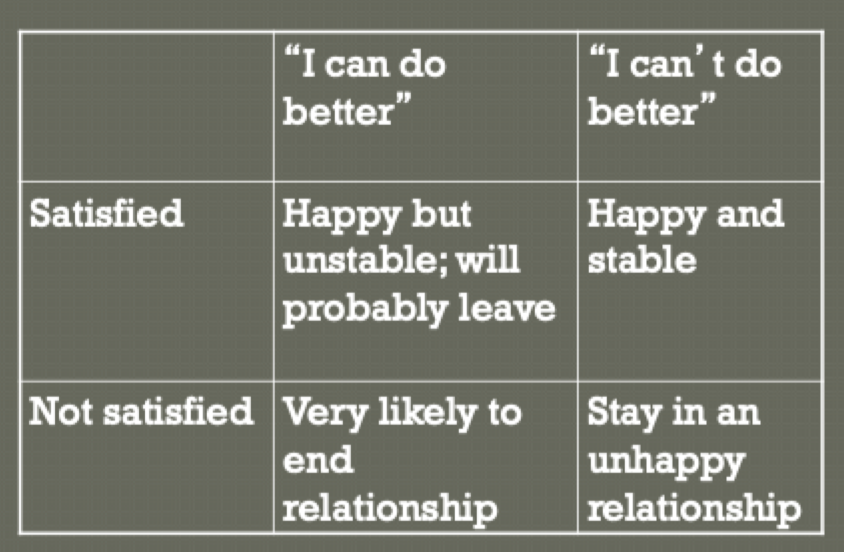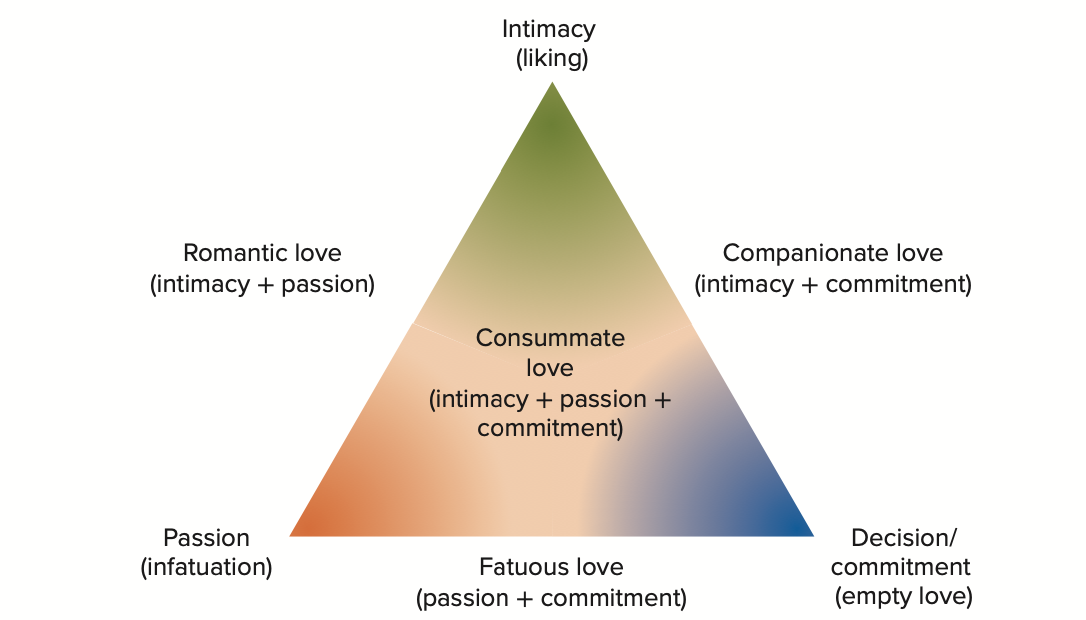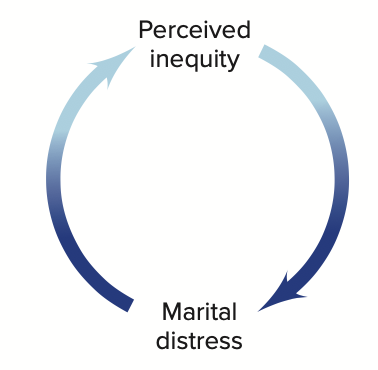Chapter 10: Attraction & Intimacy (liking and loving others)
1/43
There's no tags or description
Looks like no tags are added yet.
Name | Mastery | Learn | Test | Matching | Spaced |
|---|
No study sessions yet.
44 Terms
What 3 factors influence our choice of close friends and partners?
Proximity
Physical attractiveness
Perceived similarity
Proximity effect
Proximity = the physical distance between 2 persons
Proximity effect → the closer someone is = the more likely we are to start a relationship with them
Functional distance
The closeness between places in terms of interaction opportunities
Friendship formation in apartments experiment
65% said = closest friend was in the building
41 % said = closest friend lived next door
22% said = closest friend lived 2 doors down
What causes the proximity effect?
Proximity effect → the closer someone is = the more likely we are to start a relationship with them
We have a higher probability of meeting and interacting with people who are closer in distance
Anticipating interacting with someone boosts liking for them → motivated reasoning effect
Familiarity → we tend to like familiar things
Mere-exposure effect
T or F: Majority’s of people’s favourite letters are ones that are used in their name
TRUE → familiarity creates liking
Mere-exposure effect
Tendency for new stimuli to be liked more & rated more positively after being repeatedly exposed to a person
Ex. you prefer letters than are included in your name
Physically attractive people are more likely to . . .
Marry (or re-marry)
Achieve good grades
Attain prestigious occupations
Get lighter crime sentences
Halo effect
The belief that physically attractive people have a wide range of positive characteristics
'“What is beautiful is good”
AKA → physical-attractiveness stereotype
Ex. people seen as more kind sensitive, warm, responsive, and likeable after plastic surgery
Is the halo effect actually true?
No → they are not any more intelligent, dominant, happy, or mentally healthy
But also yes → they are more comfortable and component in social settings (more socially skilled)
What influences attractiveness?
Facial symmetry → the degree to which 1 side of the face is similar to the other
Facial averageness
Matching hypothesis
The tendency to choose partners who we believe are a “good match” in attractiveness and other traits
What factor determines what kinds of relationships we have?
Attachement style
What are some formative studies on attachment style?
Harlow → attachment in monkeys (nurturing cloth mother)
Bowlby → our 1st important relationship = mom/primary caregiver
Ainsworth → strange situation determines attachment style (4 different type)
What are the different types of attachment styles as describe in the strange situation paradigm?
*Secure attachment = reliable caregiver → good, dependable bond
Avoidant attachment = unavailable caregivers → baby is independent and apathetic
Anxious/ambivalent attachment = unpredictable and undependable caregiver
What are the 2 dimensions to measure attachment on?
Anxiety → the extent to which a person worries about being abandoned or rejected by others
Avoidance → the extent to which a person feeling discomfort with closeness and emotional intimacy in relationships
Secure attachement
*Central to human life!
Optimistic beliefs about relationships
Trusting others
Feeling that they can handle threats
Doesn’t fret about getting too dependent or being abandoned
Finds it easy to get close to others
Relationship tends to be satisfying and enduring
Anxious attachment
INSECURE ATTACHMENT STYLE
Overdependence on parter for comfort and support
High anxiety individuals may bring about the rejection they fear
Less trusting (compared to secure)
Possessive and jealous
May break up repeatedly with same person
Emotional and angry during conflicts
Avoidant attachment
INSECURE ATTACHMENT STYLE
Striving to maintenance distance, control, and self-reliance in relationships
Avoiding negative emotional stares
Low intimacy in relationships
Tends to be less invested and more likely to leave relationships
More likely to engage in 1 night stands
What 2 factors determine whether people stay together or break up?
Social exchange theory
The investment model
Social exchange theory
People make decisions about their relationships by weight pros and cons
Staying together depends on:
Satisfaction → how happy are you in the relationship?
Presence of attractive alternatives → can you do better?
These 2 factors can be crossed so that relationships fit into 1 of 4 quadrants

Investment model
*Based on social exchange theory
Satisfaction is determined by:
Rewards
Costs
Commitment is determined by:
Satisfaction
Alternatives
Investments

Secure attachment style
LOW avoidance & LOW anxiety
Optimistic beliefs about relationships
Finds it easy to get close with others
Does not Frey about getting too dependent or being abandoned
Relationships are satisfying and enduring
Feels that they can handle threats
Attachment styles with high anxiety
Overdependence on partner for comfort and support
Less trusting
Possessive and jealous
May break up repeatedly with the same person
Emotion and angry when discussing conflicts
Attachment styles with high avoidance
Striving to maintain distance, control, and self-reliance in relationships
Avoiding negative emotional states
Low intimacy in relationships
Tends to be less invested → more likely to leave
More likely to engage in one-night stands
What is the best predictor of whether any 2 people are friends?
Proximity to one another
Causes repeated exposure & interactions → allows us to discover similarities and to feel each other’s liking
Reward theory of attraction
We like people whose behaviour we find rewarding OR whom we have associated with rewards events
We like those we associated with good feelings
Love
Intimacy → liking
Passion → infatuation
Commitment → empty love

Two-factor theory of emotion
Arousal from any source (even painful experiences) can intensify passionate feelings
Arousal x its label = emotion
Companionate love
The affection we feel for those whom are lives are deeply intertwined
Initial romance high moves into a more steady, affectionate relationship
When is companionate love most likely to occur?
When both partners feel the partnership is equitable
They both precieve themselves as receiving from the relationship
What is a reward of companionate love?
Opportunities for intimate self-disclosure
Disclosure reciprocity → being open with one another
What are factors that predict relationship separation?
Age
Education
Values
Similarity
(Individualistic cultures) valuing feelings > commitment
Need to belong
Motivation to bond with others in relationships that provide positive, ongoing interactions
Complementarity
In a relationship between 2 people = each completes what is missing in the other
Ingratiation
The use of strategies (ex. flattery) to try and gain favours from others
If ulterior motive is present = praise/compliment loses appeal
Passionate love
A state of intense longing for a relationship with another
Passionate lovers = absorbed in one another
Partners feel ecstatic at attaining the other’s love → they don’t want to loose it
Equity
When the outcomes people receive from a relationship are proportional to what they contribute to it
NOTE= Equitable does not always mean equal
T or F: perceived inequity can cause marital distress
TRUE

Self-disclosure
Revealing intimate aspects of oneself to others
Disclosure reciprocity
We reveal more to those who have been open with us
You reveal → I reveal
What are some factors that predict people staying married?
Married after 20
Both grew up in stable, two-parent homes
Dated for a long while before marriage
Are well and similarly educated
Enjoy a stable income from a good job
Live in a small town or on a farm
Did not cohabit or conceive a pregnancy before marriage
Are religiously committed
Are of similar age, faith, and education
What are some destructive responses to relationship distress
Neglect → ignoring partner
Exit → ending the relationship
What are some constructive responses to relationship distress
Loyalty → awaiting improvement
Voice → seeking to improve relationship